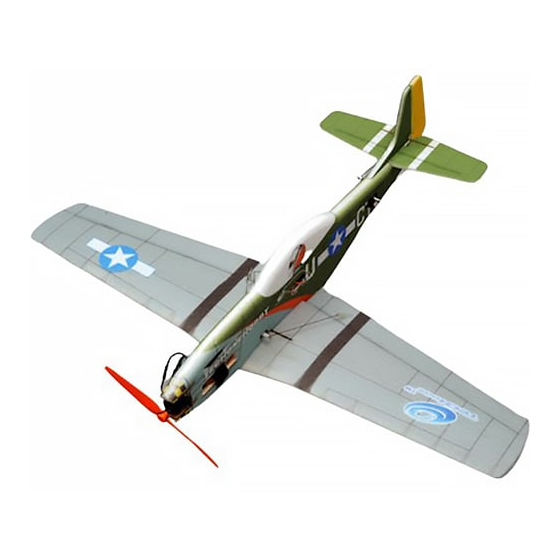
Table of Contents
Advertisement
Quick Links
Before operating this unit, please read these instructions completely.
Features:
1.Epp-P51D is epp fun fighter for outdoor flying.
2.made of High quality EPP material, it is very strong
, durable, easy to fly .
3.very easy to build , because most of the parts pre-
assembled in our factory already . You will see it
from the attached files.
Do not fly under the conditions as below
Wind strong enough to make the trees rustle
A street with many trees or street lamps
Close to high voltage electrical wires
High Population density areas
Cautions for flying
Large gyms, front lawns and parks make excellent
flying areas. Make sure you have permission to fly
and follow safety guidelines set by local authorities.
The calmer the wind, the better!
Note for Storage
Please disconnect the lipo packs when finished
flying
Do not press or crush the airplane when storing
The best way to store is to hang the airplane to keep
the control surface rigid
Recommended Flying Setup
Max servo travel of aileron:15degrees up and 15degrees
down( 8mm)
Max servo travel of elevator:15 degrees up and 15 degrees
down(10mm)
Max servo travel of rudder:20degrees left and 20 degrees
right ( 15mm)
Product Specifications
Fuselage length: 680mm (26.8in.)
Wingspan: 840mm (33.0in.)
Flying Weight:320-350g (with battery)
Motor: T2208 or T2212
ESC: 15-20Amp
Propeller: GWS 8040
Servo: 8g micro servo * 3pcs
Radio: 4/more channels
Battery: 11.1V 600-1000mAh Li-po 20C
CG Position:
45-53mm from the leading edge of the wing,.
45- 53mm
Advertisement
Table of Contents

Subscribe to Our Youtube Channel
Summary of Contents for Techone EPP-P51D
- Page 1 Fuselage length: 680mm (26.8in.) Wingspan: 840mm (33.0in.) Features: Flying Weight:320-350g (with battery) 1.Epp-P51D is epp fun fighter for outdoor flying. Motor: T2208 or T2212 2.made of High quality EPP material, it is very strong ESC: 15-20Amp , durable, easy to fly .
- Page 2 Body par ts included in the packing 1.Use the reamer to expand the hole of the extention 1 Fuselage 1pcs servo arm , in order to install the pushrod connector. 2 Wing (right and left) 1pcs 3 Elevator (stabilizer) 1pcs 4 Rudder(vertical tail) 1pcs parts included in the packing...
- Page 3 80mm 6.Use a knife to cut a horn slot so as to install the servo . 4.If the pushrod connector gear do not match with the servo gear , pls use the above methods to adjust so as to make it suitable. 7.Firstly install the z-bend into the horn ,and then glue the horn into the pre-cut slot.
- Page 4 9.Use same method to install the horn and pushrod of the left and right aileron A B 11.Glue the horizontal stabilizer , pls make sure A=B. A B 12.Glue the vertical stabilizer into the fuselage. 10.Glue the wing and the fuselage joined , each conjunction should be glued together.
- Page 5 16.Use a knife to cut a elevator servo slot 13.Install the servo arm. 17.Install the elevator horn and pushrod , the method is same as installing aileron horn and pushrod . 18.Use the screwdriver to tighten the pushrod screw. 14.Install the pushrod connector into the servo arm , and then put the horn onto the servo.
- Page 6 21.Connect the motor and ESC , Pls make sure the motor running direction is correct , if not , pls discretionarily exchange any two wires of the three Wires . 22.Tighten the motor by using the screws which included into the motor bag. 23.Install the ESC into the pre-cut slot of the fuselage, install the battery pack into the next slot of the ESC by using the velcro.
- Page 7 25.Pls use the servo extention wire if the servo wire 27.Use a O-ring to fix the propeller . is not long enough. A perfect EPP-P51D is done after your careful assembly. While assembly, the flying weight is really critical to the flight performance and will be affected by adding weight, so you should reduce any unnecessary weight while assembly.















Need help?
Do you have a question about the EPP-P51D and is the answer not in the manual?
Questions and answers